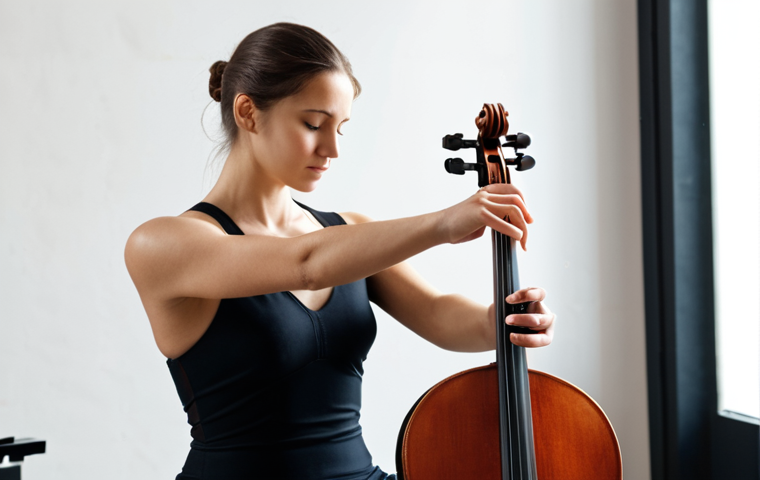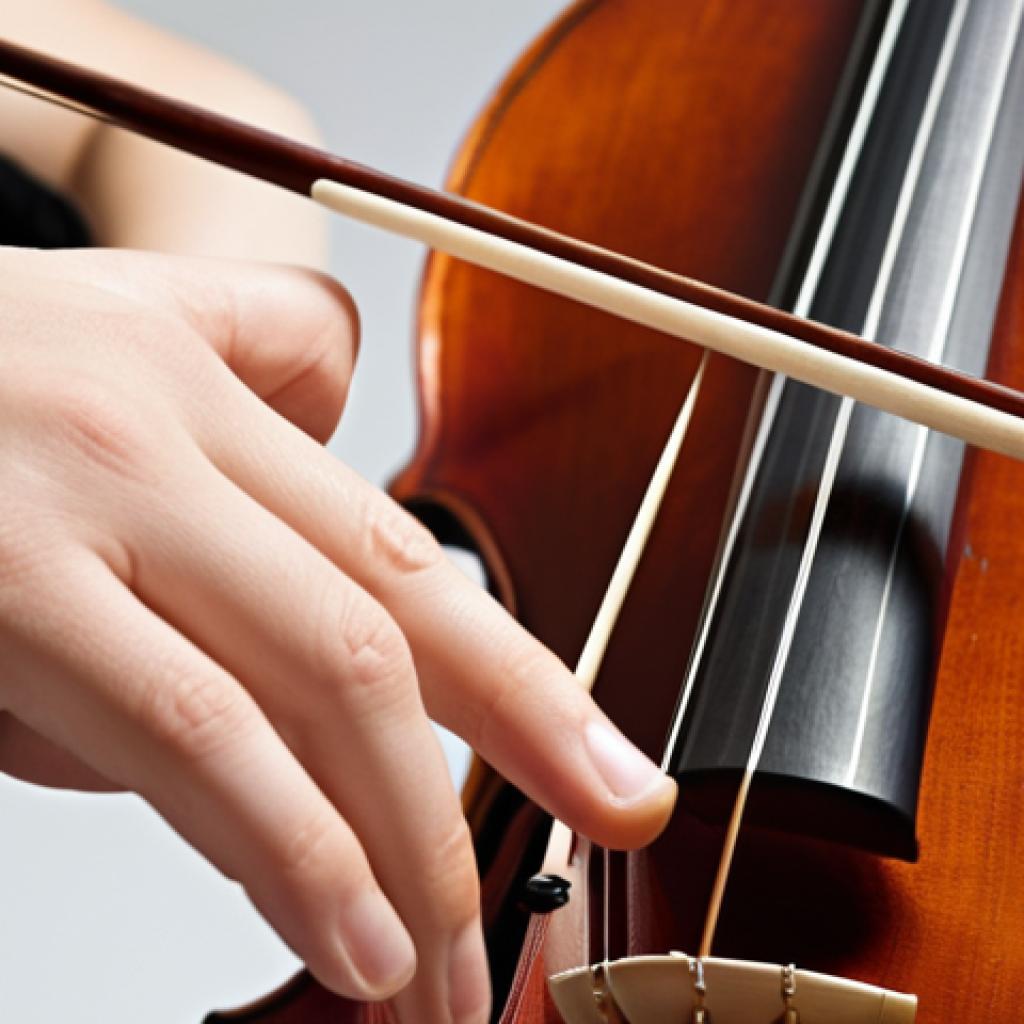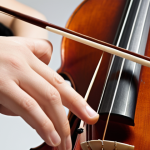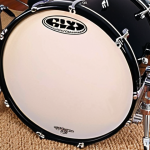Ever picked up a cello bow and felt like you were holding it all wrong? I know I did! It’s trickier than it looks, and getting a good grip is crucial for producing a beautiful sound.
I remember one time, my bow hold was so off that my teacher actually stopped the entire orchestra just to correct me (embarrassing, but helpful!). A proper bow hold isn’t just about comfort; it directly impacts your tone, control, and overall playing experience.
So, are you ready to master the art of the cello bow hold and unlock your musical potential? Let’s get the details right in the following article!
Alright, let’s dive into perfecting that cello bow hold!
Achieving a Balanced Grip: The Foundation of Your Sound

A balanced bow hold is all about finding that sweet spot where the bow feels like an extension of your arm. When I first started, my teacher would place the bow in my hand and gently guide my fingers until I found that balance point.
It’s not about gripping too tightly or letting the bow flop around; it’s about equilibrium. Too much tension, and your sound becomes scratchy and forced.
Not enough, and you lose control, resulting in a weak or uneven tone. This balance allows for nuanced control over dynamics and articulation, and honestly, it’s a game-changer.
Finding Your Natural Balance Point
Experimenting with different positions to discover where the bow naturally wants to sit in your hand is the key. I remember one of my instructors suggesting closing my eyes and letting my hand relax completely before placing it on the bow.
This helped me avoid pre-conceived notions and discover my hand’s natural inclination. The goal is to have the bow feel like it’s floating effortlessly, ready to respond to the slightest movement.
The Importance of a Flexible Wrist
A flexible wrist is essential for smooth bow changes and expressive playing. Think of your wrist as a shock absorber, cushioning the bow’s movement and preventing jarring sounds.
Practice wrist exercises away from the cello to build flexibility and control. I would often spend a few minutes each day doing wrist rotations and figure-eights to improve my dexterity.
This flexibility translates directly into a more fluid and natural bowing technique.
The Role of Each Finger: A Symphony of Coordination
Each finger plays a specific role in controlling the bow, and understanding their individual contributions is crucial for developing a refined technique.
When I was first learning, I often focused too much on one or two fingers, neglecting the others. My teacher pointed out that it’s like conducting an orchestra; each musician (or finger) has their part to play, and they need to work together harmoniously.
The Thumb’s Gentle Support
The thumb acts as a pivot point, providing stability and allowing the bow to rock slightly. It should be curved and relaxed, not pinched or stiff. I remember struggling with thumb tension for months, which caused my bow to shake uncontrollably during performances.
Eventually, I learned to consciously relax my thumb, and the shaking disappeared almost immediately. It’s amazing how such a small adjustment can make such a big difference.
The Index Finger’s Guiding Influence
The index finger is responsible for controlling the weight and pressure of the bow on the string. It should be curved around the bow, providing a balanced downward force.
I used to grip the bow too tightly with my index finger, resulting in a harsh and scratchy tone. My teacher suggested practicing scales with varying degrees of pressure, focusing on achieving a smooth and consistent sound.
The Middle and Ring Fingers: Partners in Harmony
These fingers provide support and stability, working together to maintain a balanced grip. They should be curved and relaxed, mirroring the shape of the index finger.
I found that focusing on these fingers helped me achieve a more rounded and full tone. They act as a counterweight to the index finger, preventing the bow from digging into the string.
The Pinky’s Balancing Act
The pinky is often overlooked, but it plays a crucial role in lifting the bow off the string and controlling off-string strokes. It should be gently curved and resting on top of the bow, providing a delicate counterbalance.
I remember my teacher constantly reminding me to keep my pinky engaged, even during sustained notes. This prevents the bow from feeling heavy and allows for greater control over dynamics.
Troubleshooting Common Bow Hold Issues
Even with the best instruction, you may encounter challenges along the way. Here are some common issues and how to address them.
The Death Grip
Holding the bow too tightly is a common mistake, especially for beginners. This can lead to tension, fatigue, and a harsh sound. Focus on relaxing your hand and fingers, and let the bow do the work.
I used to squeeze the bow so hard that my hand would cramp up after just a few minutes of playing. Learning to trust the balance of the bow and relax my grip was a game-changer.
The Floppy Bow
On the other end of the spectrum is the floppy bow, where the fingers are too relaxed, and the bow feels unstable. This can result in a weak tone and a lack of control.
Engage your fingers and find that balance between tension and relaxation. Think of it like holding a bird: you want to hold it gently but firmly enough to prevent it from flying away.
The Knuckle Crunch
Bending the knuckles too much can create tension and limit flexibility. Keep your fingers curved but relaxed, avoiding any sharp angles. I had a tendency to hyper-extend my knuckles, which caused pain and stiffness.
Focusing on maintaining a gentle curve in my fingers helped alleviate the tension and improve my bow control.
Bow Hold Styles: French, Russian, and German
There are different schools of thought when it comes to bow hold, each with its own unique characteristics.
The French Bow Hold
The French bow hold is the most common and versatile style. It emphasizes flexibility and control, allowing for a wide range of tonal colors and articulations.
The bow is held with a balanced grip, and the wrist plays a crucial role in bow changes and dynamics. It’s what I was originally taught and found it to be incredibly adaptable.
The Russian Bow Hold
The Russian bow hold is characterized by a higher wrist position and a more angled bow. This allows for a powerful and projecting sound, ideal for solo playing and large orchestral settings.
I’ve seen some incredibly talented cellists use this hold to produce a tone that can fill an entire concert hall.
The German Bow Hold
The German bow hold is similar to the French hold but with a more relaxed and open hand position. This allows for a warm and rich sound, particularly well-suited for Romantic-era repertoire.
While not as widely used as the French hold, it can be a great option for players seeking a more mellow and expressive tone.
The Importance of Regular Practice and Adjustments
Mastering the cello bow hold is an ongoing process. Don’t expect to perfect it overnight. Consistent practice and a willingness to make adjustments are key to achieving a comfortable and effective technique.
I still find myself tweaking my bow hold from time to time, even after years of playing.
Consistent Self-Assessment
Record yourself playing and analyze your bow hold. Are you gripping too tightly? Is your wrist flexible enough?
Are your fingers working together harmoniously? Identifying areas for improvement is the first step towards progress. I often record myself during practice sessions and then watch the videos later, paying close attention to my bow hold and posture.
Seeking Feedback From a Teacher
A qualified cello teacher can provide invaluable feedback on your bow hold and offer personalized guidance. They can identify subtle issues that you may not be aware of and help you develop a more refined technique.
I would never have been able to correct my thumb tension without the help of my teacher.
The Long-Term Benefits of a Proper Bow Hold
Investing time and effort into developing a proper bow hold will pay off in the long run. A comfortable and efficient bow hold will allow you to play with greater ease, control, and expressiveness.
It will also help prevent injuries and allow you to enjoy playing the cello for many years to come. Here’s a table summarizing the key aspects of the bow hold:
| Element | Description | Key Focus |
|---|---|---|
| Thumb | Curved and relaxed, providing support | Avoid pinching or stiffness |
| Index Finger | Controls weight and pressure | Balanced downward force |
| Middle and Ring Fingers | Provide stability and balance | Curved and relaxed, mirroring the index finger |
| Pinky | Balances the bow and controls off-string strokes | Gently curved and resting on top of the bow |
| Wrist | Flexible and fluid | Smooth bow changes and expressive playing |
Preventing Injuries
A poor bow hold can lead to repetitive strain injuries, such as tendonitis and carpal tunnel syndrome. By developing a comfortable and efficient bow hold, you can minimize the risk of these problems.
I know several cellists who have had to take extended breaks from playing due to bow hold-related injuries. Taking the time to learn a proper technique can save you a lot of pain and frustration in the long run.
Expressing Yourself Through Music
Ultimately, the goal of a proper bow hold is to unlock your musical potential. By mastering the fundamentals, you can focus on expressing yourself through the music and connecting with your audience.
I remember the first time I truly felt connected to the music I was playing. It was a transcendent experience, and it wouldn’t have been possible without a solid foundation in bowing technique.
So, keep practicing, keep experimenting, and keep striving for that perfect bow hold. It’s a journey worth taking.
Wrapping Up
And there you have it – a deep dive into the art of the cello bow hold! Remember, mastering this takes time, patience, and a lot of practice. Don’t get discouraged if it feels awkward at first; every great cellist has been there. Keep experimenting, keep adjusting, and most importantly, keep playing! The journey to a perfect bow hold is a rewarding one, filled with beautiful music and endless possibilities.
Handy Tips & Tricks
1. Consider using a bow hold buddy: These handy little tools help guide your fingers into the correct position and can be especially helpful for beginners.
2. Practice in front of a mirror: This allows you to visually assess your bow hold and make adjustments as needed.
3. Film yourself: Recording yourself playing can help you identify areas where your bow hold might be faltering.
4. Take breaks: Avoid practicing for extended periods without breaks to prevent fatigue and injury. A few minutes of stretching can make a world of difference.
5. Consult a professional: A qualified cello teacher can provide invaluable feedback and guidance, tailoring their instruction to your individual needs.
Key Takeaways
• Balance is everything: Strive for a balanced grip where the bow feels like an extension of your arm.
• Each finger has a role: Understand the function of each finger in controlling the bow.
• Flexibility is key: Maintain a flexible wrist for smooth bow changes and expressive playing.
• Practice consistently: Regular practice and self-assessment are crucial for improvement.
• Listen to your body: Pay attention to any pain or discomfort and adjust your technique accordingly.
Frequently Asked Questions (FAQ) 📖
Q: I’m a complete beginner. Is the cello bow hold really that important from the start?
A: Absolutely! I remember thinking I could just muscle through it at first, but boy, was I wrong! A bad bow hold from the get-go can lead to all sorts of problems down the line – a scratchy tone, difficulty with dynamics, and even wrist pain.
It’s like building a house on a shaky foundation. Getting it right early on, even if it feels awkward at first, will save you a ton of frustration and help you progress much faster.
Think of it as an investment in your cello journey!
Q: Okay, I’m convinced. What are some common mistakes people make with their cello bow hold?
A: Oh, the mistakes are plentiful! I’ve seen it all, and I’ve probably made most of them myself. One biggie is gripping the bow too tightly.
It’s like death-gripping a golf club – it tenses everything up and kills your sound. Another common one is having a ‘flat’ thumb, which restricts your wrist movement.
And then there’s the ‘chicken wing’ elbow, where your elbow sticks way out to the side. Believe me, you’ll look like you’re trying to fly! The key is to stay relaxed, have a flexible wrist, and keep your elbow relatively close to your body.
Q: Is there a “perfect” bow hold, or does it vary from person to person?
A: That’s a great question! While there are definitely fundamentals to a good bow hold, like a curved thumb and a relaxed grip, there’s no single “perfect” hold that works for everyone.
We all have different hand sizes, finger lengths, and playing styles. What feels natural and comfortable for one person might feel completely wrong for another.
The best approach is to work with a qualified teacher who can assess your individual needs and help you develop a bow hold that’s both effective and comfortable for you.
They can fine-tune your technique and address any specific challenges you might be facing. Think of it as customizing your bow hold to fit you like a glove!
📚 References
Wikipedia Encyclopedia




